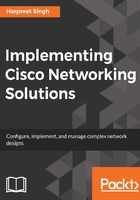
Ethernet
Ethernet is the most popular physical layer LAN technology in use today, as it strikes a good balance between speed, cost, and ease of installation. These benefits, combined with the ability to support most layer 3 protocols, make Ethernet an ideal networking technology for most computer users today. Ethernet is defined in the standard IEEE 802.3.
Ethernet is available in a wide range of speeds, using different types of physical cables and connectors. While Ethernet started at a basic speed of 10 Mbps, it is today available at speeds of 10 Mbps, 100 Mbps, 1 Gbps, 10 Gbps, 40 Gbps, and even 100 Gbps, all of which are in use today in the industry. The lower data rates up to 1 Gbps usually have copper interfaces running Unshielded Twisted Pair (UTP) cables with standard RJ45 connectors. The most common form of cabling standard used in the Ethernet industry is Cat5e that can carry 1 Gbps signals up to a length of 100 m. As the data rates increase, optical cables are used to connect Ethernet ports as there is no electromagnetic interference, and the signals are carried across larger distances. The optical cables connect to the Small form-factor pluggable (SFP) transceiver that provides a modular interface for the Ethernet port at a physical layer. SFPs available today can safely drive native Ethernet up to a length of 40 kms and beyond. Ethernet interfaces can be half or full duplex, and can autonegotiate speed for multirate interfaces.
Ethernet was developed for a shared medium, and hence any frames transmitted by a node on the Ethernet interface can be received by all other nodes on the same LAN. Ethernet uses Carrier Sense Multi Access/Collision Detection (CSMA/CD) technology to detect whether the medium is idle. This is important as the medium is shared between all nodes, and the receiver has to ensure that there is no other host transmitting on the physical medium at that point in time. However, there are still some chances of collision as two hosts at the remote ends of the shared medium may start to transmit at the same time. This leads to collisions of frames, and the devices have to backoff as per the protocol standards and wait before retransmitting the frame again. A larger number of hosts on the shared medium increase the chances of collisions and hence reduce the throughput of the link.
An Ethernet frame is as shown in the following figure with the field lengths in bytes given in parentheses for every field:

- The Destination MAC Address and Source MAC Address are the Media Access Control (MAC) layer addresses of the interface. These addresses are burnt into the physical Ethernet adapter, also called the Network Interface Card (NIC).
- The Type field denotes the higher layer protocols carried in the Ethernet frame. A common value is 0 x 0800 for IP, and 0 x 0806 for Address Resolution Protocol (ARP) that we will describe next.
- The Data field is the actual payload, which is an IP datagram where the Ethernet is carrying IP datagrams. In this case, the type field is set to the hex value of 0800.
- Frame Check Sequence (FCS) is a 4-byte field that denotes the check sum to be used to verify whether the frame has been received without errors or needs to be discarded.
Ethernet adds an overhead of 18 bytes to the payload because of the header fields. The maximum frame length that can be transmitted by the Ethernet interface is called the Maximum Transmission Unit (MTU). Since there is no fragmentation at the Ethernet layer, the maximum size of the IP datagram that can be transmitted is 18 bytes less than the MTU of the Ethernet link for untagged frames. The header length increases with 802.1Q tags, which we will describe in the section on VLANs.